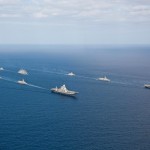For centuries, the psyche of India has been that of a landlocked country. This is partly due to its history, recent wars and the resultant political thought and defence structures. But now, India has to face the truth: turn to the sea or face a very constricted future.
The reason is simple and known to most people through this statistic: two-thirds of planet earth is water and 90% of the world’s trade flows through the ocean. What lies beneath is becoming increasingly contested.
This contest is sharpening thanks to multiple shifts in the world, both economic and political. The biggest of these is the ascent of China simultaneous with the U.S.’s turning inwards and the consequent shifts in the world’s geopolitical architecture – a structure that has largely remained unchanged since the end of the second world war, and which has entrenched western interests.
The choppiness created by these changes is visible in the Indian Ocean region through China’s increased naval capacity and territorial ambitions. Its exaggerated historical claims are piggybacking on its economic heft. The Maritime component of the “One Belt One Road” (OBOR) that connects Europe, Asia and Africa to Beijing through transport links is being seen as the most overt manifestation of China’s global ambitions. But it could also be seen as a last-ditch attempt by China to keep social stability by salvaging a slowing economy – one plagued by an infrastructure overdose and overcapacity in key sectors like steel and cement, and a real estate bubble.
The outbreak of violence in West Asia during the past decade adds to the sea-bourne challenge India faces. That regional dependency is acute: 6 million Indians work in the region, remitting $33 billion home annually, and Delhi secures 65% of its total crude oil imports from West Asia. It’s not all bad, for the situation also opens up diplomatic space for India as old alliances loosen, the threat of terrorism becomes more widely felt and the role of Pakistan acknowledged.
One of these opportunities is the financial and political “mainstreaming” of Iran to the west and Myanmar to the East, after the end of western sanctions. It is also a challenge because both countries are pivots in China’s OBOR and Beijing has established itself in the ecosystem of those territories. For instance in Myanmar, oil and natural pipelines have already started pumping hydrocarbons to China. In Iran, Beijing connected Tehran[1] to the eastern Chinese province of Zhejiang through a 10,400 km-railway line. The first train arrived in Tehran in February.
For India, these developments mean that policy makers should keep a sharp eye on the eastern and western seaboards, while fast-tracking projects in Myanmar and Iran, to quickly convert goodwill into influence there. These projects include the Kaladan Multimodal Transit Transport[2] that connects Kolkata with Myanmar’s Sittwe port and then to India’s remote north eastern state of Mizoram. Development of the Chabahar port in Iran will help Delhi secure the Iranian oil needed to keep its economy running, and gain access to both Afghanistan and energy-rich Central Asia.
Indian policymakers are now more alert to the challenges and opportunities. Prime Minister Narendra Modi has sought peace and economic integration with Bangladesh by ratifying the land boundary in May 2015[3]. And he has invested a lot of diplomatic capital and time in his visits to Saudi Arabia, United Arab Emirates and the tour of three-island nations in the Arabian Sea in the past year.
To the east, India has progressively engaged with the ASEAN countries, Japan and Australia- which are feeling the heat of China’s rising ambition – by conducting naval exercises and bilateral exchanges[4]. Japanese premier Shinzo Abe has invested equal energy in trying to change his country’s pacifist orientation from the post-second world war, while expanding the strategic element of his country’s bilateral relations with India, all in order to confront Chinese aggressiveness. If India wants to be a net security provider in the region, it can’t realize this goal without having a bigger blue water navy. To build this naval strength, India needs to keep increasing Navy allocation from the present level of 15% of the defence budget. A possible model for this could be the U.S. Navy that has sought 30% of the 2016 U.S’s proposed defence budget of $585.3 billion.
This is progress – but slow progress. Completing existing commitments will create the space for new sea-facing opportunities, both strategic and commercial. Only then will India be able to maintain its strategic autonomy in the Indian Ocean, while being more than just a counter balance to China.
Neelam Deo is Co-founder and Director, Gateway House: Indian Council on Global Relations; She has been the Indian Ambassador to Denmark and Ivory Coast; and former Consul General in New York.
Aditya Phatak is a senior researcher at Gateway House.
This article was exclusively written for Gateway House: Indian Council on Global Relations. You can read more exclusive content here.
For interview requests with the author, or for permission to republish, please contact outreach@gatewayhouse.in.
© Copyright 2016 Gateway House: Indian Council on Global Relations. All rights reserved. Any unauthorized copying or reproduction is strictly prohibited.
References
[1] Ministry of Foreign Affairs of the People’s Republic of China, Foreign Minister Wang Yi Meets the Press, 9 March 2016,< http://www.fmprc.gov.cn/mfa_eng/zxxx_662805/t1346238.shtml>
[2] Gateway House, Asia’s strategic corridor’s to India, 11 July 2013, <https://www.gatewayhouse.in/asias-strategic-corridors-to-india/>
[3]India Code, The Gazette of India, 29 May 2015, <http://www.indiacode.nic.in/acts-in-pdf/2015/CONST100.pdf>
[4] Institute for Defense Studies and Analyses, Malabar-2015 and Power Dynamics in the Asian Commons, 23 October 2015, <http://www.idsa.in/idsacomments/Malabar2015andPowerDynamicsintheAsianCommons_asingh_231015>


